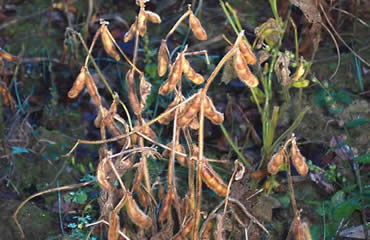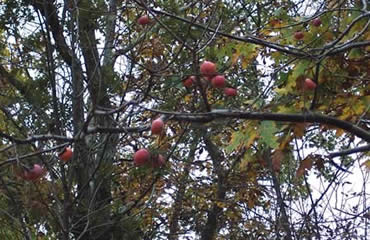I thought my first attempt at a food plot was a dismal failure. It was late October, the deer had barely touched the crop, and I was beginning to think I’d wasted my time and money. I had, after all, committed the cardinal sin of not testing and treating the soil. Maybe that was it. But the plants came up just the same — big, leafy fronds of brassica.
Initially, I’d walk down and check it every day, even though I could see the plot from my back window. After a while, I stopped checking. Eventually I didn’t even bother to look from the house. About a week later, while pulling in the driveway after a morning hunt, a flash of white caught my eye as a deer bounded out of the plot. That made me curious, so I went down to have a closer look.
I couldn’t believe my eyes. The place was torn up. Brassica fronds, some that had been nearly a yard long, were gone, eaten down to thumb-size stems. And the frost-covered ground was littered with deer tracks. That’s when the light went on. Frost. As soon as it hit the brassicas, starches turned to sugar, and the deer hammered it. In a week, most of the little plot was down to stems. It was a dramatic example of how a whitetail’s diet shifts during the fall.
The Transition
While summer and winter are rather static, fall is a season of transition between the two. During this transition, the whitetail’s nutrition needs — and their diet — shifts. Being able to identify and even anticipate these shifts can give you an edge in planning your fall strategies.
In the summer, plants and animals are growing. Bucks are growing a new set of antlers, while does feed their ever-growing fawns. The deer’s greatest nutritional need is protein, which they get by grazing on herbaceous vegetation like clover, alfalfa and other grasses and forbs.
As days become shorter and summer wanes, those plants cease growing and ripen, preparing for winter’s dormancy. Meanwhile, deer stop growing, too. Does wean their fawns. Circulation is cut off to velvet on a buck’s antlers, so it dies and falls off. Now a deer’s greatest need is to put on as much fat as possible before winter. And its diet shifts.
In some cases, the transition is gradual. In others, like the aforementioned brassicas, it’s rapid and conspicuous. There are some diet shifts that are more difficult, maybe even impossible, to predict. In those cases, you should be ready to react when they occur.
Mast
The most pronounced shift is from high-protein to high-carb foods, and one of the most common in the deer’s autumn diet is mast. High-carb foods include hard mast like acorns, beechnuts and hickory nuts, and soft mast like apples and berries.
Research has shown that, wherever they occur, acorns are the number one fall favorite food of the white-tailed deer. Acorns are produced by two different types of oaks, and knowing the difference can be important in predicting diet shifts. For the most part, those in the white oak group have round-lobed leaves. Under good conditions, they’ll produce acorns every year. White oak acorns tend to mature and drop earlier than those of the red oaks. They’re also smaller and have fewer tannins.

As a result, deer typically head to white oaks first. For many white oak species, particularly in the Southeast, the shift is sudden and short-lived. Almost overnight, the oaks start to shed their burden, and the deer are on the new plenitude so fast it’s as if they’ve been waiting for it (maybe they have).
Red oaks — characterized by leaves with pointed lobes — produce nuts in alternate years under good conditions. They produce larger acorns that typically fall later, and with certain exceptions, the drop tends to be a bit more prolonged. Usually when both groups (red and white) occur in the same area, deer will hit the white oak acorns first, then shift to the reds, which allegedly have more tannins, making them bitter.
In poor years (too wet or too dry), red oaks might not produce acorns at all, or might produce few or smaller nuts. Furthermore, the red oak mast crop isn’t synchronous. Trees in one area might produce one year, while those in another produce the next. That makes tracking the diet shifts a bit more challenging, but also reduces the number of options where deer will go when the shift occurs.
Localized Shifts
It’s difficult to generalize about diet shifts because often they can be quite localized. For example, in my part of the country in the Northeast, red maple is the most common hardwood species. When the leaves die, they change color, turning the woods ablaze with vibrant red, yellow and orange hues.
Then, one night a hard frost falls over the lowlands. The next morning, leaves rain down on the forest floor. Like the brassicas, their starches have turned to sugars and the deer relish them, but only within a day or two of drop. If you’re in the right place at the right time, results can be dramatic.
Persimmons are a smallish tree of the East-Central and Southeastern U.S. Deer love them, but only after they ripen and fall. According to good friend and Trebark founder Jim Crumley, “a ripe persimmon will rarely last the night.”
Windfall
Sneaking toward my stand in the pre-dawn darkness, I was a bit apprehensive. This would be my first sit for the season at this particular location, and I hadn’t scouted the area in several weeks. I was playing a hunch, so it would likely be either boom or bust.
Some of my trepidation was allayed when I heard a loud snort followed by the staccato footsteps of running deer on dry oak leaves. I felt even more confident when the ground started to roll under my feet. I turned my flashlight on just long enough to sneak a peak and saw exactly what I’d hoped for: the forest floor was littered with green acorns.

Three days earlier, the after-effects of a tropical storm spiraled up the coast and smashed into southern Maine. Rain came down in sheets, while wind rocked the treetops like a hula skirt. Then, a high pressure system pushed the front out to sea on gusty northwest winds.
I’d hung a stand in the oak grove weeks before, anticipating I wouldn’t use it until much later, when the acorns typically drop. But the storm had provided an unexpected opportunity that I wasn’t about to pass up.
We use the term windfall to describe a sudden, unexpected abundance of wealth — like winning the lottery. It’s derived, literally, from bounty knocked out of trees by the wind. And if we go back to the literal meaning, it applies quite aptly to deer.
Unlike ordinary mast drop, windfall creates some very sudden and dramatic diet shifts. Where I live, bow season starts in early September, when deer haven’t really gotten into the acorns yet. However, early fall is also hurricane season, and when the easterlies blow, acorns fall like hailstones.
To take advantage of this, you need to know where the big acorn producers are before they start to drop. That’s made easier if you have a lot of white oaks where you hunt. My area is dominated by red oaks, which produce nuts every other year, and only when conditions are right. I’ve got to go out and find which groves, or individual trees, have nuts. Then I store that information until conditions are right. That’s typically later in the season, but I’m always on call in case of a premature windfall.
Those same storms, and just about any other sustained precipitation in early to mid-fall, also produce another type of windfall crop: mushrooms. Deer seem to relish mushrooms. It might take several days, but after a soaking rain, mushrooms pop up, turning areas where they occur into temporary deer magnets. Mushrooms are often most abundant under pine stands, but this can vary considerably with local conditions.
Anthropogenic Shifts
Anthropogenic is just a fancy word for man-made, and man can be responsible for some of the most dramatic diet shifts, both positive and negative. The best example is agriculture. We plant corn, alfalfa and soybeans, all of which attract deer, though not necessarily at the same time.
Alfalfa, for instance, is a high-protein crop most utilized in summer and early fall.
If they can get to them when they first sprout, deer will eat corn plants. After that, they pretty much leave them alone until the ears ripen in the fall, creating an easily accessible high-carb food source. Similarly, they’ll usually leave soybeans alone until after they ripen.
When ripe, these crops become deer magnets, but only until they’re harvested. Then, the deer must shift again, though instead of another food, it might just be the same food on another farm. If you hunt agricultural areas, pay close attention to who’s cutting when, as that can significantly influence your success.
In the north country, there’s an adage that deer come running to the sound of a chain saw. That’s a bit of an embellishment, but it carries a note of truth. Where there’s no agriculture or mast, deer must survive on woody browse, preferring the smaller buds and twigs of hardwoods. A timber operation where the loggers cut the trees and leave the tops produces a bounty of browse in an otherwise lean environment. And it’s not unusual to see deer entering the cuts while the loggers are still packing up for the day.
Conclusion
There are countless more examples depending on where you hunt and on the specific conditions each year. That’s why tracking diet shifts is an ongoing task. You have to stay on top of things. Learn to anticipate when the diet shifts might occur and be ready to react, sometimes with less than a day’s notice. If you learn to read and predict diet shifts, you’ll have more protein in your diet as well.
This article was published in the August 2007 edition of Buckmasters Whitetail Magazine. Join today to have Buckmasters delivered to your home.